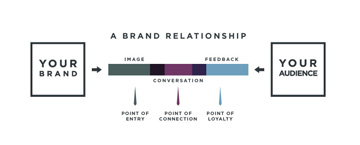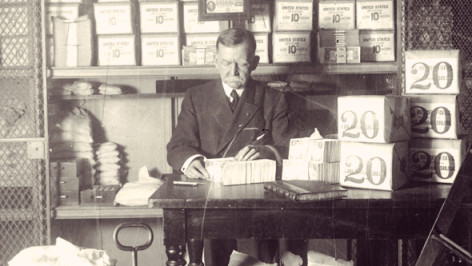The crush of content marketing has created a sea of digital noise. There is still excellent storytelling out there; in fact, social media can help us find even more and more of it. But the real challenge is to find powerful stories in a landscape of mediocre ones that are merely being called “great.” The best content is that which we find ourselves and want to share because it is truly “great.” I think a good example of this is Kid President. This project caught on and spread worldwide. The content is good and pure and fun and true. And because the story is right, it is “great,” and we know it as soon as we see it!
Branding is a relationship. It is a conversation. The relationship exists between the brand – of a business, organization, or even professional individual personality – and its audience.
At Macy Advertising we believe that powerful brands are built by going through three basic stages of a brand relationship cycle: image, conversation, and feedback.
Image is the point of entry.
Conversation is the point of connection.
Feedback is the point of loyalty.
When we talk about “branding” as a modern business concept, the image stage of the relationship is what comes to mind first. Your image is the way you represent yourself to your audience – the logo and visual identity, the appearance of your store or points of sale, website, etc. This is the VITAL first step in establishing a good brand relationship; the face of the brand is its point of entry into a relationship with the audience. The audience sees the brand’s product – do they like the packaging? is the design in-line with their tastes? was the video cool? do they identify with the photography?
If the image of the brand appeals to the consumer, then often times the relationship begins.
This is where most people stop when they are talking about branding. “Let’s design a brand!” someone says. So they make a logo, they make a website, they shoot a commercial, they print stationary, and they produce packaging. And then that’s it.
Powerful brands can be created when those involved in the process see branding as a dynamic and more holistic effort. We no longer live in an age where mass marketing is king. Blanketing audiences with generic advertising and seeing who responds is not how we have to operate anymore. Instead, we are now able to build a conversation around and with our customers. We need to actively engage with our customers – to supply the information that they want, and create conversations and messages that built a connection. Good design communicates powerful messages. Effective branding is not simply nice aesthetics; effective branding possesses the opportunity to serve as a carrier vessel of a dialogue between the brand and the audience (just make sure it’s a message worth telling).
It can go further, too. We need our customers to become part of the tribe by connecting with them and keeping up with them over time. The best brands in the world send personal letters, produce videos with messages that people can really relate to, tailor email campaigns, interact socially through events, etc – which makes them feel more connected to the company. And not only this, but then the brands lets their audience speak back, and – and this is huge – the brand really listens. Then, because it has connected with its customers, and the customers have had a chance to speak their mind and feel heard as influencers in the future of the company, loyalty to the brand builds inside the customer. Seeking new customers – building image – is typically 5 to 7 times more expensive than retaining existing customers – retaining loyalty. And loyalty isn’t the only result – the brand also gains the powerful insight of active and engaged consumers, creating an opportunity to go back to the first stage of the process and shape, tweak and redefine the image and information that the brand puts forward in effort to better represent and appeal to its audience, thereby constantly honing in further and further on a “brand” with which its customers more truly identify. Over time, we craft a better and stronger brand image by listening to the feedback from our conversations with the audience.
We reverse engineer the brand design and visual identity; we create out of what we know our customers want. Because we listened.
Dynamic branding in today’s market is a brand built around a two-way conversation. Powerful brands will create ways to build a conversation around their audience and engage them beyond fading-out, impersonal one-way advertising. More than this, they will be brands that listen up when their customers talk back. Marketing will only become more and more democratized; make sure your brand strategy gets the memo.
Social media has claimed a firm place of importance in branding for a while now. There is no denying its many benefits when it comes to building a platform and creating a powerful touchpoint between the company and its customers as the closest-thing-to-word-of-mouth marketing that we have available. It leverages being able to talk to your audience, track how and who they talk to about your brand, and aggregate all of this data to provide demographics on a social and personal level. As far as advertising and public relations are concerned, it’s been a game changer – and it’s here to stay.
In our modern economy, the big box landscape is diminishing; we are turning scale on its head, and are pursuing small over big. “Shop Local.” “Know who makes it.” A key aspect of successful branding as we move into this new era of of scale implosion will be to push away the idea of becoming a large-scale corporate brand, and pursue the idea of becoming a brand that is close and relatable to the consumer. Brands can now engage customers on a more personal level, and the opportunity to build a smaller following of incredibly passionate people will be far more powerful than trying to build a large following of disorganized individuals who do not really have an affinity or loyalty to the company on any level of real engagement.
Certain brands will do well to work with the stereotype of a “social” brand – minimal / modern / flat works well for a lot of new tech companies. But for others to copy it just because it is trendy is really only a dis-service to the social platforms they could truly build if they were to try and define a personality for their company and communicate who they are and what they stand for in a clear, approachable way.
We can help you find your voice. Click to have Bob Macy call you today>
The twenty-first century has been dubbed, among other things, the “Information Age.” We live in a period of time where, more than ever before, endless information has become available to any one at any time. The creation of the Internet made knowledge present at our fingertips – so much so that any question we may have is easily answerable within seconds of a Google search. Now that the vast majority of individuals have this technology compacted to a smartphone that they carry with them everywhere, a car ride’s conversation with friends can be fact checked on the go by that one person that always wants to be right.
But the Information Age defines us not merely in the prevalence and accessibility of data, but also in the value shift that it has brought within us. Information is now something that we venerate. It changes the way that we interact with brands and products. Brand loyalty is not only based in the hip aesthetic of its identity, but in its message and how it informs us. As that brand shares quality information in its messaging and culture, it gains a position of trust in our minds. Effective brands will position themselves as experts in their field.
We live in the Information Age – not only because we are surrounded by it, but because it is the currency of successful marketing in our time.



